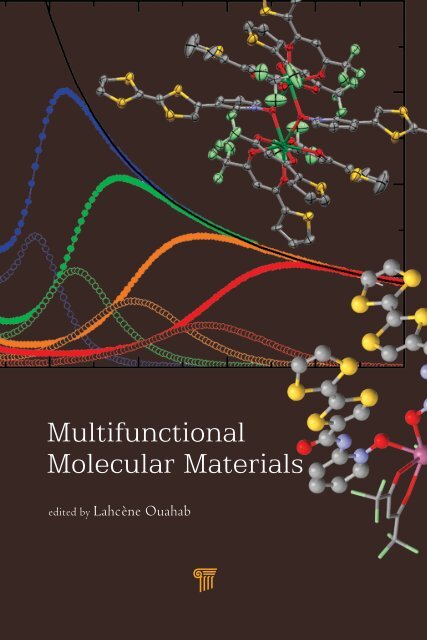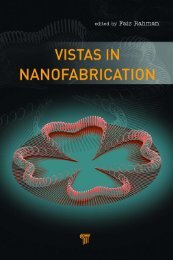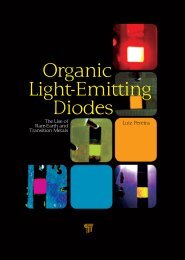Download PDF - Pan Stanford Publishing
Download PDF - Pan Stanford Publishing
Download PDF - Pan Stanford Publishing
Create successful ePaper yourself
Turn your PDF publications into a flip-book with our unique Google optimized e-Paper software.
Published by<strong>Pan</strong> <strong>Stanford</strong> <strong>Publishing</strong> Pte. Ltd.Penthouse Level, Suntec Tower 38 Temasek BoulevardSingapore 038988Email: editorial@panstanford.comWeb: www.panstanford.comBritish Library Cataloguing-in-Publication DataA catalogue record for this book is available from the British Library.Multifunctional Molecular MaterialsCopyright © 2013 <strong>Pan</strong> <strong>Stanford</strong> <strong>Publishing</strong> Pte. Ltd.All rights reserved. This book, or parts thereof, may not be reproduced in anyform or by any means, electronic or mechanical, including photocopying,recording or any information storage and retrieval system now known orto be invented, without written permission from the publisher.For photocopying of material in this volume, please pay a copying feethrough the Copyright Clearance Center, Inc., 222 Rosewood Drive,Danvers, MA 01923, USA. In this case permission to photocopy is notrequired from the publisher.ISBN 978-981-4364-29-4 (Hardcover)ISBN 978-981-4364-30-0 (eBook)Printed in the USA
Contentsvii2.2.1 Introduction 672.2.2 Structures of {Mn II 2 MnIII 2 (hmp) 6 (MeCN) 2 }{Pt(mnt) 2} 2][Pt(mnt) 2] 2 · 2MeCN and[{Mn II 2 MnIII 2 (hmp) 6 (MeCN) 2 }{Pt(mnt) 2} 4][Pt(mnt) 2] 2682.2.3 Physical Properties of [{Mn II 2 MnIII 2 (hmp) 6 (MeCN) 2 }{Pt(mnt) 2} 2][Pt(mnt) 2] 2 · 2MeCN and{Mn II 2 MnIII 2 (hmp) 6 (MeCN) 2 }{Pt(mnt) 2 } 4 ][Pt(mnt) 2] 2712.2.3.1 Electrical conductivity 712.2.3.2 Magnetic properties 722.2.4 Conclusion 772.3 Manganese-Salen Type Out-of-Plane Dimer SMMswith Metal–Dithiolene Complex: Integer OxidationState of the Metal–Dithiolene Moiety 772.3.1 Introduction 772.3.2 Structure of [Mn(5-Rsaltmen){M III (dmit) 2}] 2(R = Me, MeO; M = Ni, Au) 792.3.3 Physical Properties of [Mn(5-Rsaltmen){M III (dmit) 2}] 2(R = Me, MeO; M = Ni, Au) 812.3.3.1 Electrical conductivity 812.3.3.2 DC magnetic property 822.3.3.3 Magnetostructural correlation 842.3.3.4 AC magnetic property 862.3.4 Conclusion 882.4 Manganese–Salen Type Out-of-Plane Dimer withMetal–Dithiolene Complex: Noninteger OxidationState of the Metal–Dithiolene Moiety 892.4.1 Introduction 892.4.2 Structures of [Mn(5-MeOsaltmen)(solvent)] 2[Ni (dmit) 2] 7. 4(solvent)(solvent = acetone, MeCN) 902.4.2 Physical Properties of [Mn(5-MeOsaltmen)(solvent)] 2[Ni(dmit) 2] 7. 4(solvent)(solvent = acetone, MeCN) 92
viiiContents2.4.2.1 Electrical conductivity 922.4.2.2 Magnetic property 932.4.3 Conclusion 952.5 General Conclusion 953. Multifunctional Single-Molecule Magnets andSingle-Chain Magnets 105Ling-Chen Kang and Jing-Lin Zuo3.1 Introduction 1053.2 Conductive Single-Molecule Magnets 1063.3 Photoluminescent Single-Molecule Magnets 1123.4 Photochromic Single-Molecule Magnets 1143.5 Chiral Single-Molecule Magnets andFerroelectric Single-Chain Magnets 1183.6 Functionalized Single-Molecule Magnets 1223.7 Other Emerging Areas of Single-MoleculeMagnets and Single-Chain Magnets 1243.8 Conclusion 1254. Magnetism and Chirality 133Katsuya Inoue and Jun-ichiro Kishine4.1 Introduction 1334.2 Space Groups of Crystal 1354.3 Symmetry and Complex Magnetic Structures 1364.4 Magnetic Structure for Asymmetric Materials 1384.5 Nonlinear Magneto-Optical Effects ofChiral Magnets 1384.6 Magnetic Structure of Molecule BasedChiral Magnet 1394.7 Magnetic Chirality and Crystal Chirality 1434.8 Epilogue 1435. Toward Bifunctional Materials with Conducting,Photochromic, and Spin Crossover Properties 149Lydie Valade, Isabelle Malfant, and Christophe Faulmann5.1 Introduction 1495.2 Conductive and Photochromic Salts 152
Contentsix5.2.1 Association Donor/Photochromic Anions 1555.2.2 Association Acceptor/Photochromic Cations 1625.3 Conductor and Spin Crossover 1635.4 Conclusion 1746. Electroactive 4f Lanthanides Complexes InvolvingTetrathiafulvalene Derivatives as Ligands: Magnetismand Luminescence 185Fabrice Pointillart, Stéphane Golhen, Olivier Cador,and Lahcène Ouahab6.1 Introduction 1866.2 Neutral Coordination Complexes:Molecular Building Blocks for p– f MagneticConducting Materials 1886.2.1 Mononuclear Complex [Gd(hfac) 3(TTF-CONH-2-Pym-1-oxide) 3](CH 2Cl 2)0.5 (C 6H 14) 1886.2.2 Binuclear Complexes [Ln 2(hfac) 5(O 2CPhCl)(TTF-CONH-2-Py-N-oxide) 3]·2H 2O withLn = Pr and Gd 1896.2.3 Binuclear Complex [Tb 2(hfac) 4(O 2CPhCl) 2(TTF-CONH-2-Py-N-oxide) 2] 1936.3 Oxidized Coordination Complex {[Gd(hfac) 3(-TTF + COO – )] 2}: A coordinating p–f System 1966.4 Conclusion 2117. Multifunctional Materials of Interest inMolecular Electronics 219M. Laura Mercuri, Paola Deplano, Angela Serpe, andFlavia Artizzu7.1 Introduction 2197.2 Magnetic Molecular Conductors 2227.2.1 Paramagnetic Conductors 2247.2.2 Paramagnetic Chiral Conductors 2307.2.2.1 Ferromagnetic conductors 2367.2.3 Single-Component Paramagnetic Conductors 238
Contents7.2.3.1 SCMMs containing a TTF moiety 2397.2.3.2 SCMMs containing a thiophenemoiety 2457.2.4 SMMs-Based Conductors 2517.3 Processing of mono/multifunctionalmolecular materials 2627.4 Conclusion 267Index 281
PrefaceMolecular materials are exciting and promising materials for thenear-future generation of electronic devices and informationprocessingsystems at the nanoscale level because of their chemicaland physical peculiarities. In the last decade, there have beenwonderful developments in molecule-based materials as regardstheir electrical conductivity, magnetic interactions, and opticalproperties. The relevance of these materials in materials scienceis mainly due to the almost infinite tuning of their physicalproperties by conventional chemical synthetic methods throughsoft routes, from organic chemistry to coordination chemistry tosupramolecular chemistry. This opens unprecedented possibilitiesfor the design of objects with the desired size, shape, charge, polarity,and electronic properties. Owing to important perspectives inboth fundamental sciences and applications in nanotechnologyor molecular electronics, for example, considerable efforts arecurrently being made to design and investigate new materials,named multifunctional molecular materials, which involvecoexistence or interplay or synergy between multiple physicalproperties.This book discusses molecular materials that combine two ormore physical properties and focuses on electrical conductivity,magnetism, single-molecule magnet behavior, chirality, spin crossover,and luminescence. It is not intended to give an exhaustiveview of all possible materials—for example, materials combiningelectrical conductivity with chirality are not presented. The materialsreferred to cover transition metal and lanthanide coordinationcomplexes as well as genuine organic materials. Their potentialapplications in molecule-based devices are also discussed.This volume is divided into seven chapters. Chapter 1, acontribution of T. Sugawara et al., gives a comprehensive reviewof the theory and experimental results related to the bifunctionalproperties of conductivity and magnetism, which are the mostfundamental physical properties of molecular solids. In chapters 2and 3, M. Yamashita et al. and J.-L. Zuo et al. present the recent
xiiPrefacedevelopments in electrical conductivity versus single-moleculemagnet and single-chain magnet behavior. Magnetism and chiralityare presented in chapter 4 by K. Inoue et al., while in chapter 5L. Valade et al. review electrical conductivity and spin crossoversystems. F. Pointillart et al. focus on magnetism and luminescencein chapter 6. Finally, L. Mercuri et al. conclude the book withchapter 7, which discusses multifunctional materials in molecularelectronics.Lahcène OuahabWinter 2012
















